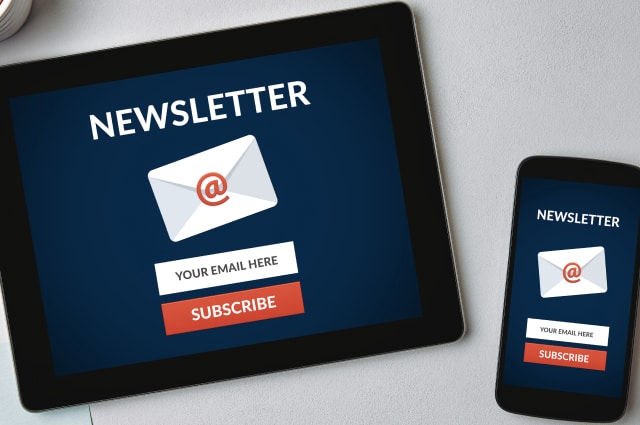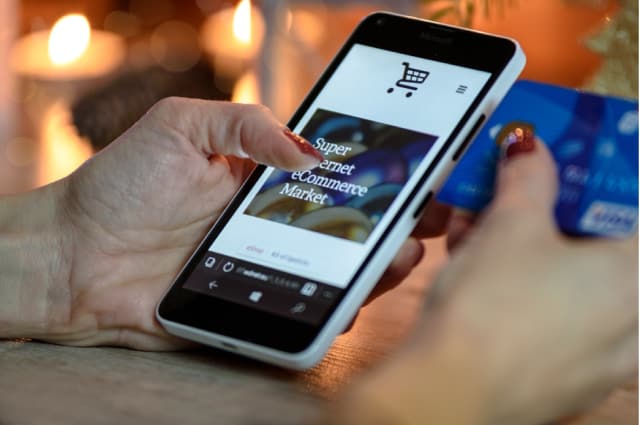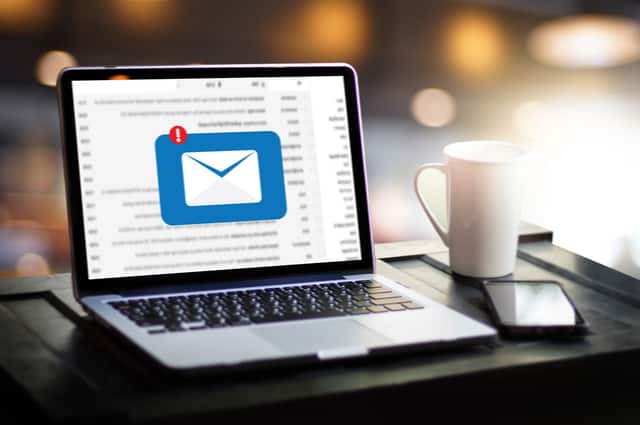Email Marketing Plan – How to design an Effective email marketing strategy easily?
After eons of hard work, you have finally managed to open your dream store. What felt like an impossible task is a reality, and you can’t wait for people to applaud your hard work and buy your products.
Ok, so the launch goes excellent, and for a couple of months, you are rightfully basking in your success. But six months later—there is a sudden anticlimax—everything goes hush, and you are sitting at your store, swatting flies and meditating over more sales and customers.
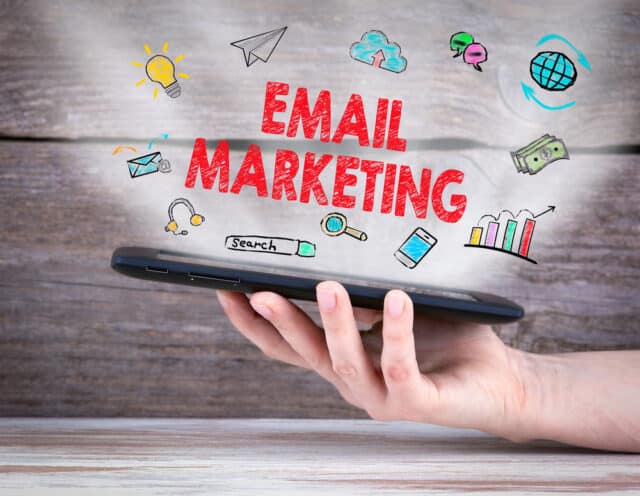
The key to running a successful business lies in consistently engaging existing customers, enticing potential customers to do business with you, and increasing sales. Let’s not forget the global pandemic has left several entrepreneurs scrambling to expand their business or lure customers.
So, how exactly should you crush the competition and forge ahead? Yes, you are right; build a powerful email marketing campaign. This is easier said than done. A business marketing strategy involves various critical tactics, procedures, and practices. Not to forget, businesses are constantly evolving their marketing efforts to develop a robust marketing campaign so as to stay a notch higher above the rest.
There is, however, a diamond among the heavy pile of marketing strategies—even today, an effective email marketing plan is validated to be one of the most potent methods that promise to deliver the highest ROI of all marketing channels.
Most effective one-on-one communication—understanding email marketing campaigns
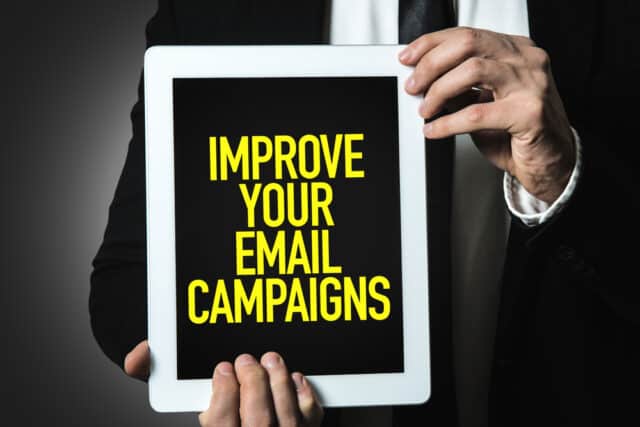
Email marketing is one of the most effective channels of digital marketing strategy. A direct form of marketing, it allows you to send commercial, personalized messages to your email subscribers or your email clients.
An email marketing campaign is a form of influencer marketing used for nurturing leads, sales augmentation, brand awareness, value generation, customer loyalty, and community building.
Previously an email marketing strategy was more about standard bulk mailings. Today, effective email marketing campaigns focus primarily on personalization, segment customers, as well as consent. As such, they include everything from order confirmation emails transactional emails to newsletters.
Email campaigns play a pivotal role in the expansion and evolution of modern businesses. Let’s find out some of the common objectives that companies fulfill through an email marketing strategy—
Know why email marketing efforts are still relevant in 2022
Drives sales

Businesses widely use email strategies during the launch or promotion of their products and services. This marketing strategy helps to gain new customers, increase conversion rates, and strengthen customer loyalty by offering a discount or special offer on birthdays/anniversaries, welcome emails, or reengagement emails.
Creates brand awareness
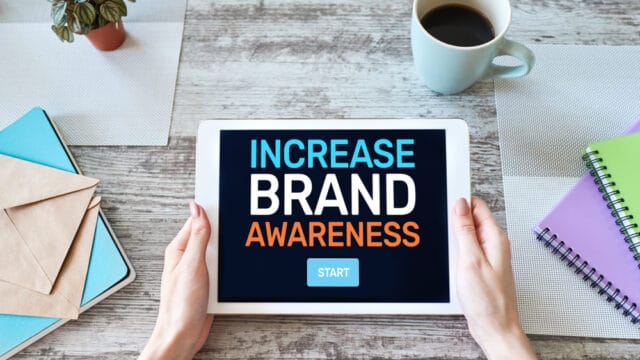
The unique feature of a successful email marketing strategy is that it allows you to reach a customer directly. To highlight your brand in someone’s inbox, the right marketing emails can do you wonders. Moreover, scalability comes with a significant benefit, i.e., you can personalize messages based on behavior tactics. As such, with your email marketing strategy, you reach a large number of recipients and at a lower cost if you compare it with other marketing channels.
Improves customer retention
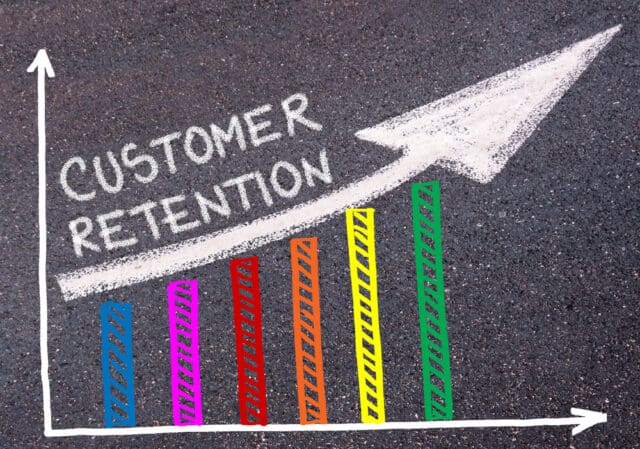
One way to achieve customer loyalty in your business journey is by creating personalized emails. Furthermore, your marketing campaign works constructively with a valuable newsletter to generate leads, onboarding, conversion, retention, and community building.
In a nutshell, email marketing is the most accessible and affordable form of mainstream marketing.
Accessible because you can reach all age groups and a diverse audience.
Affordable because it is incredibly cost-effective.
Today there is a plethora of practical email marketing tools that suit all pockets.
Learn from the best— Let’s look at some of the best email marketing campaign examples
Example 1
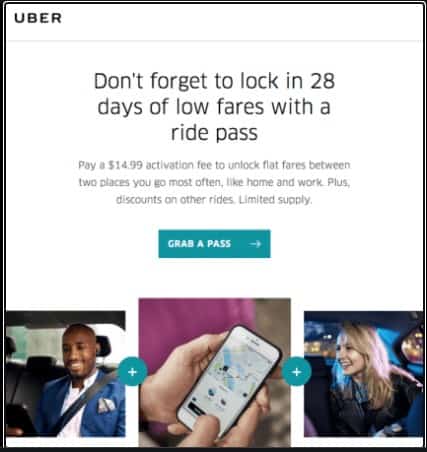
You are looking at Uber’s straightforward email campaign. Let’s learn why this is a good email strategy—
- The brief text calls to action at a simple glance.
- It provides a link option for subscribers who wish to know more.
- The goal is clearly laid out—to promote a special offer.
Example 2
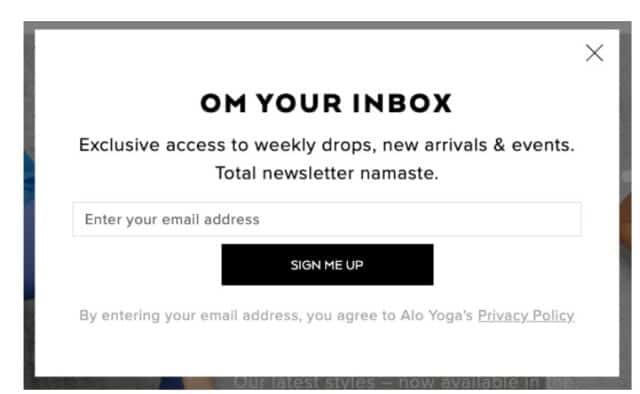
You are looking at Alo Yoga’s informational email. Let’s learn what makes it a good email strategy—
- It encourages visitors to join the mailing list by clearly citing what’s in store for them—weekly tips and styles, events, with a hard-to-miss CTA.
- The subject line is catchy, language is simple and personal to people who love Yoga.
- The message does not insinuate urgency and sound nagging.
Example 3
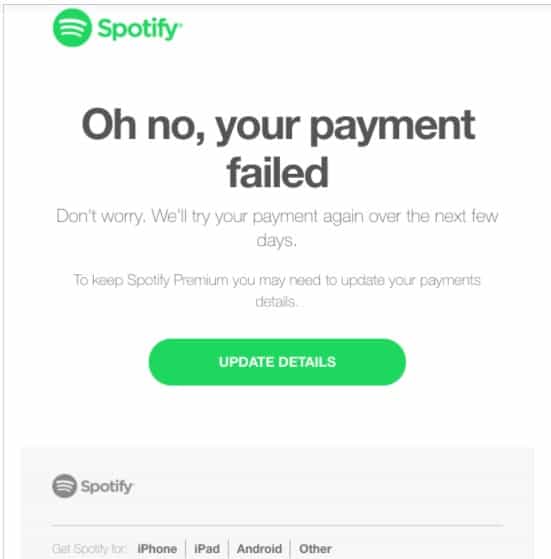
You are looking at Spotify’s reminder email. Let’s learn why this is a good example—
- It encourages subscribers to take action without intervening.
- The message is simple. It nudges users to sort out the issue but has a playful and subtle approach rather than sounding desperate.
- There is a clear CTA option.
Let’s get down to business—How to build mailing lists?
Create signups
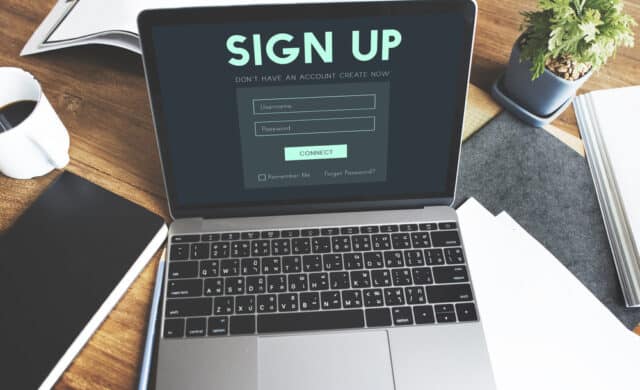
Driving signups for your email campaign is one of the most widespread practices for building mailing lists. And what’s more, there are a plethora of means for collecting customer data through this method! Let’s explore some options to create signups—
Use signup forms
Ok, so this may sound like a piece of advice from an ancient book, but this old-school trick is actually a great way to build your email list. Whether you are hosting a launch party or asking customers to fill it after a purchase, the good old-fashioned signup form will do you wonders.
You will instantly get to know about their interests, among other details. Furthermore, you can also keep track of how many people will love to hear from you. To say the least, you will also have their email address!
Use social media

The majority of people use social media for leisure, if not all. Therefore, driving signups and collecting email addresses through social media when they have a few minutes on their hand can be an excellent start to your email campaign. You can either share a signup form through your social media handles. An alternative and intelligent way is to create a contest, in which case, users will need to sign up as part of the competition. Long answer short, make use of your social media following to build a substantial email list!
Alternatively, you may also consider adding a signup button to your business pages on Facebook, Twitter, and LinkedIn accounts. The instant’ click here to sign up option will attract more followers, not necessarily those who follow you but also others who would probably like to receive your newsletter.
Pitch a signup option in your email signature
Here’s another option for people who are not comfortable pitching their email newsletter on social media—create signup through a link in your email signature—this link will take your users directly to the signup option on your website; it could also be signup for an email newsletter or a link to a blog post with CTA, or to one of your landing pages. Refer to the nature of established outcomes to select your signup option.
Use website signup
Another option is to provide a signup form on your website. This way, when users find something impressive about your business model, they will want to stay in the loop about your products.
Create a newsletter
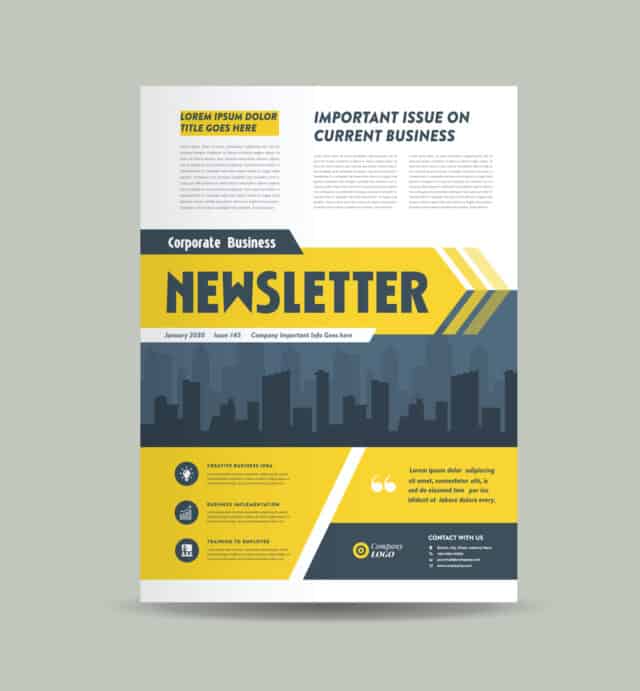
A creative newsletter of your brand is guaranteed to reach a wider audience. You can create signup or subscribe option for the newsletter. Pitching your newsletter signup on all your social media channels, along with the website, will add niche members to your mailing list.
Furthermore, if you create a newsletter that surrounds only one or two topics, you can even create a personalized CTA (call-to-action) to encourage users to sign up immediately. You may create a catchy CTA that best describes the newsletter’s contents, such as, “Want to make Bitcoins for free? Sign up for our newsletter!”
Build a landing page
A landing page provides several options to grow your email list. Using appealing imagery valuable content with a straightforward and clear CTA will nudge people to sign up. Experts also believe that the more landing pages you create, the more personalized and curated content you can offer. This further attracts a much broader and more diverse audience.
Offer freebies
Well, we don’t have to remind you of the perks of discounts or a voucher. We all are big fans of free gifts! Giving people the option to sign up by offering an attractive incentive or a discount code on their first purchase will win your business new subscribers; we promise you that! This trick always works.
Host events
Hosting online and offline events is a popular marketing strategy practiced by several businesses. Especially during the pandemic, online webinars, workshops, training courses, among others, are a great way to increase your mailing list. You can link the signup for the event to your company’s signup form.
Use a pop-up or slide-in for your landing pages
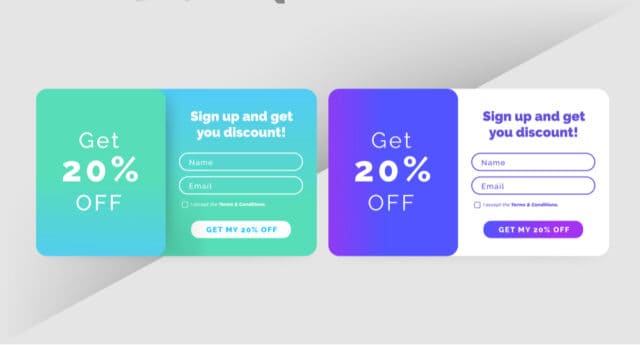
Well-timed pop-up ads or onsite retargeting are a great way to lure users into becoming subscribers. Start by actively monitoring user behavior. After a user has spent a certain amount of time on your page, a pop-up based on exactly what she was looking at will increase your click rate.
You can use exit pop-ups for users when they try to leave the page or scroll pop-ups that appear at a certain page break-up. Make sure that your pop-ups are not intrusive or obtrusive. The idea is to make them helpful. This way, you can attract visitors with quality content just when they need it.
Finally, we would like to suggest putting in some effort while drafting messages for your clients. Compelling emails that contain a lot of valuable information always catch people’s attention. Furthermore, allow people the option to share your emails easily through intuitive share buttons and carefully curated post builders on various social media channels. This will speed up your campaign performance.
Things are getting serious—how to develop a successful email marketing plan?
Let’s get you started on planning an email marketing campaign for your business through this simple step-by-step process—
Step 1: Know your audience
Start small—knowing what you sell and who your target audience is will help you to layout a blueprint for your marketing strategy. Having a clear judgment of your audience will also help you to communicate your services and products effectively.
Marketing automation software further comes in handy to monitor smaller sections of segment users within a more extensive base of the target audience. This way, you can send personalized and targeted email templates, thereby increasing engagement, building loyal relationships with your clients, and generating more significant ROI.
Step 2: Decide on a marketing email service provider
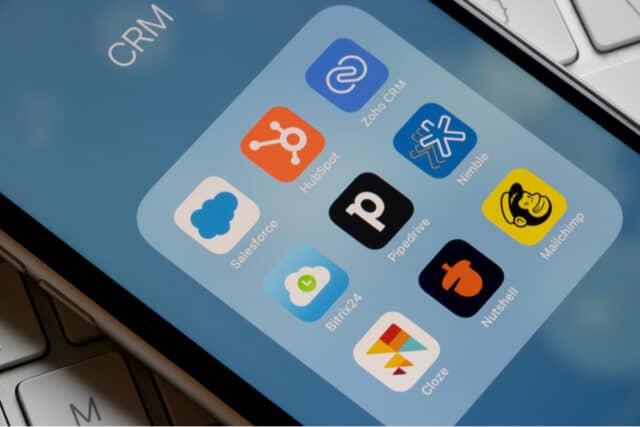
The next step in building an email marketing strategy is to find a marketing provider who is in sync with your business needs. Today, there are several email marketing tools to choose from—Hubspot, MailChimp, Constant Contact are among the most significant competitors.
While choosing marketing providers for your business needs, you may want to consider the following questions—
- What are your email marketing goals?
- Does your operation need distinguishing features that set it apart?
- How much can you afford? What is the overall budget for the marketing program?
- How flexible and cost-effective is the provider?
- What’s the headcount of your email list?
Step 3: Zoom in on your business goals and frequency
Now that you have decided on your email marketing provider, it’s time you focus on the overall goal of your email marketing campaign. Start by defining a yardstick to quantify the campaign’s success. To achieve this, you will need to pay special attention to customer acquisition and open rates.
The key is to know the purpose of your email marketing and how to build it into your marketing strategy. Your goals could be—
- Promotion of a new product
- Discount offer for loyal customers
- Request for downloads for your latest ebook
- Updating subscribers on some important piece of company news
The key is to be clear about your business goals so that you can design valuable email content.
Secondly, you need to decide how often you want to notify users of your company’s news. Here, we intend to remind you that your email marketing campaign should be targeted and purposeful. Your emails should not be a daily hodgepodge of random messages to your subscribers.
Then again, there is no thumb rule on how often you should email your users. Some businesses send daily or weekly updates to their customers, while some send them twice a month. However, we can guarantee two things: sending emails too often will tune out your message’s purpose, and your customers may unsubscribe completely.
In the end, an email marketing schedule is subjective and has to have its own pace. This can be measured by paying heed to site traffic numbers, CTRs, bounce metrics, unsubscribe metrics, etc.
Step 4: Design your emails
This step is likely to set the mood for your entire campaign strategy. Your email design and content are going to decide whether you are going to stay in business for a while.
So, while drafting your email campaigns, you need to prioritize your message—keep it concise and include a straightforward CTA.
Another pro tip is to lay out all the contents of your message in a hierarchy. Highlight the most important takeaway of your message by bringing it to the top. This way, you strengthen the chance of people reading it. To take it a step ahead- customize the email template to address your business goals. Lastly, don’t ignore other email aspects such as email subject lines, open rates, and conversion rates.
Step 5: Increase your subscriber count
Behind every effective email marketing strategy is a formidable subscriber base. We have already shared some constructive tips on how to build your email list in the previous section.
To point out a few, create email signup for your newsletter on your landing page, or create an opt-in on your website’s e-commerce page. You may also consider creating opt-in forms on order confirmations and for other customer surveys.
The key is to avoid ending up in the spam folder! This can only be achieved if you have customers who would readily opt-in to receive emails from you.
Step 6: Plan your email marketing schedule
You can make a successful email marketing strategy by planning it to the T. Create an email marketing planner with the help of a calendar. The dates will help you to plan the sending frequency for your blog posts, emails, social media posts, among others.
You may also use an email marketing calendar to design your schedule according to your business and content type.
Step 7: Test run
Before you debut in the cutthroat market, remember to take your campaign on a test drive. You also need to remember that strategies keep evolving, so be realistic and flexible.
Criticism begins at home
Send a batch of test emails to your friends, family, and coworkers. They will be your best critic. Request them to check typos and provide feedback on the design, campaign layout, etc.
Test in different ISPs
Remember, the campaign you designed in your email marketing tool appears different in your subscribers’ inboxes. Checking emails before sending them is a good practice. Furthermore, preview how the design appears on mobile devices.
Run A/B testing campaigns
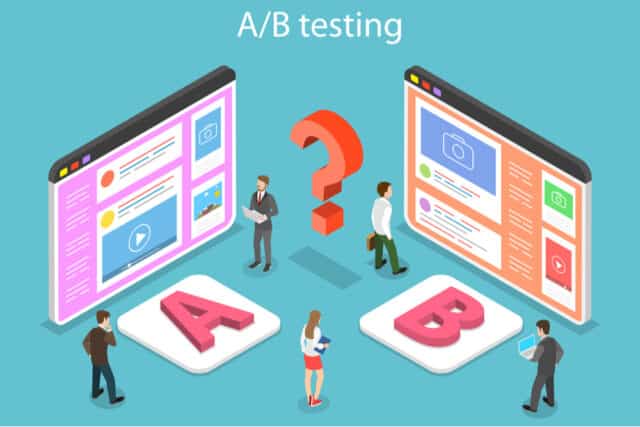
Here you need to evaluate the subject lines and your email templates. Ask yourself which subject lines will get the most open rate and clicks and at which time of the day?
Running A/B tests will help you in this regard. Experts advise it is better to experiment with different emails templates while also telling you how the changes impact your results.
Finally, test the campaigns through different measures such as email open, click, and conversion rate. It is important to measure these benchmarks to optimize your campaign’s overall design, message frequency, and subject lines. It further also allows you to fine-tune for better efficiency.
Behind the scenes—How do email marketing campaigns work?
The highlight of this section is ESPs or Email Service providers. It is an email marketing management platform or software. With their special infrastructure, ESPs ensure deliverability to bulk subscribers.
You might wonder why we are telling you about ESPs when you can also send emails through regular mailing platforms, also known as Internet Service Providers (ISPs) like Gmail, Yahoo, or even Outlook.
The problem with regular inbox providers is that they come with limited design and email bandwidth options, not to forget limitations with email deliverability. Long story short, ISPs are more suitable for personal use. When you send mass emails from ISPs, they can be flagged by spam filters, or your account could also be disabled for suspicious activities.
What makes your email campaigns successful?
We cannot emphasize enough the importance of email marketing metrics to measure the success of a marketing campaign. If you regularly focus on these Key Performance Indicators (KPIs), you will achieve your revenue goals early on. Let’s take a look at some of the most important metrics—
Open Rate
Your open rate gives you the overall percentage of opened emails by your recipients. It is one of the most important metrics because, well, how is your campaign going to be successful if no one is interested in what you have to say.
Factors that improve open rates are the sender’s name and catchy subject lines. Experts believe you need to track open rates on a weekly basis.
Click-through rates
The click-through rate provides you the percentage of email clients who clicked on the link shared by you in the email body. If subscribers click on the link, your marketing team can pat you for it, as that is more or less the main goal of your mail marketing strategy. You may measure this metric once a week.
Factors that improve the click-through rate are the anchor text on the link, the page leading to the link, and the number of times you have included the link in your email.
Unsubscribe rate
The unsubscribe rate suggests the percentage of the audience who have unsubscribed to your email. The factors that affect the unsubscribe rate are irrelevant content, frequent emails, and misleading subject lines.
Complaint Rate
Your complaint rate denotes the percentage of contacts who have ditched your email as spam. Typical factors for spam scores include purchased email lists, old email addresses, absence of value in the content, or too frequent emails, among others.
The spam score signals the internet service providers (ISPs), indicating that the contacts are no longer interested in hearing from you.
We know it’s brutal, but the spam score impacts your sending reputation and hence deliverability.
Bounce rate
Bounce rate gives you the percentage of total emails sent that ‘bounced,’ i.e., they were not successfully delivered to the recipient’s inbox. Common reasons for bounces are nonexistent email IDs, overloaded or unavailable servers, blocked incoming email, among others.
These are further categorized as a hard bounce and soft bounce. The term hard bounce is used for a permanent problem (e.g., nonexistent ID), whereas a soft bounce is a temporary problem (e.g., full inbox).
When you have more data, you can calculate the impact of your marketing KPIs more concretely. The following marketing KPIs will help you to measure the impact of your emails on your overall campaign objectives—
Conversion Rate
Well, a higher percentage of conversion rate is a positive indicator. Conversion rates measure the percentage of recipients who have done what you intended them to do. For instance, they have subscribed to your newsletter, bought your product, signed up for a webinar, etc. You can measure the conversion rate on a monthly basis.
Forward/Share rate
Another positive indicator—forward or share rate indicates the percentage of recipients who have forwarded or shared your email. Long words short, if more users are clicking on the ‘share button,’ you have earned yourself some valuable brand ambassadors.
Campaign ROI
The ROI indicates the overall return on your investment in an email campaign. In short, it tells you if your email marketing strategy was cost-effective. You can calculate ROI by— (profit minus cost) / cost.
Let’s suppose you made $100 profit from a $100 investment; your return on investment (ROI) would be 1, or 100%.
Cost per acquisition (CPA)
This metric indicates how successful your campaign is. With CPA, you can calculate how much you spent on gaining every new customer. The formula to calculate CPA for an email marketing strategy is Total campaign cost / Conversions (paying customers) = CPA.
Weave these useful KPIs skillfully into your email marketing strategy for productive results from the beginning of your email campaign. Build upon what works the best for your business, time your campaign well, list out your campaign goals, and analyze what works in the best interest of your business.
We have got you covered—pro tips to improve your email marketing strategy
Don’t buy email lists
We cannot emphasize this more, DO NOT BUY email lists. Follow our tips on how to build your own email list in the above section. Here are some of the reasons why we think buying an email list is a bad idea—
- You are not complying with the consent rules made under the General Data Protection Regulation (GDPR) and are sending emails to people without their consent. This makes you a legal offender.
- When you buy an email list, it indicates that the email addresses are free or fake and will do no good for your business. This only increases your hours on the clock and efforts, not your website traffic.
- The email recipients are not interested in your brand, so unsolicited emails from you will mostly end up as spam or in the trash folder.
- Your IP and sending reputation will go down, as you cannot keep a count of the times you have sent the email to the same email address.
Create opt-in during signup
There are two types of opt-ins for email marketing, viz.
Single opt-in: when subscribers are added to the email list on submission of the signup form.
Double opt-in: when subscribers are added after they click on the subscription link from the confirmation email sent by you. You cannot send emails to such subscribers without their verification.
Double opt-ins need extra work, but they ensure optimal email deliverability. Furthermore, you don’t have to worry about subscriber consent, spam traps, or fake IDs.
Use list segmentation
When your marketing strategy is good, your email list is likely to expand and include diverse buyer profiles. When you create different segments in your email list, you will divide your contacts into smaller sub-lists who have common interests. Relevant and targeted emails guarantee subscriber engagement.
You may want to begin with list segmentation already at the signup stage. You may also want to include your clients’ preferences in terms of content, email frequency, etc.
Personalize
Personal and thoughtful messages attention to detail is the highest emotional triggers. Don’t we love it when people go that extra mile to make us feel special? In the context of marketing emails, pay attention to the right message that calls to action. You may want to consider the following impactful tips that will ensure opens, clicks, and conversion—
- Include subscriber’s first name in the email subject line and content (“Hello Mary!”)
- Consider locations and time zones of your subscribers when you schedule your campaigns.
- Segment contacts for targeted and relevant emails.
- Create emails based on customers’ reactions to your product/service.
Make compatible for mobile phones
Experts believe about 60% of all emails today are read on mobile phones. During your test run, make sure your design capabilities are responsive to mobiles. Most of the email marketing tools offer in-built mobile preview functionality.
Improve email deliverability
The success of a marketing campaign depends largely upon email deliverability. You may want to follow some of these deliverability tips—
- There are certain words and phrases that trigger spam filters.
- Double-check if the email contents are not increasing your spam score.
- Update your subscriber database, i.e., remove unengaged and inactive users.
- Prioritize opt-in subscribers.
- Give your users the option to unsubscribe.
Revise your email list
An up-to-date database guarantees email deliverability and greater engagement. Delete subscribers who have not engaged in at least six months. You may send a reactivation email first or a second opt-in before you remove them.
A/B test
A/B testing email subject lines, email contents, and CTAs is a great way to test different tactics and optimize your campaigns. Evaluate which formulas bring you the most engagement.
Consider email automation
You may want to take your email marketing strategy a notch higher by using autoresponders. You may want to use personalized automated emails at every step in the sales cycle. Automated emails are known to be highly effective for lead generation and nurturing.
In closing, we would like to remind you that effective email campaigns need to be targeted personally and should be designed by keeping the customers’ objectives in mind. In the end, it’s all about connecting authentically with your potential clients—an essential element to sell your brand.
Remember, you don’t have to sell to every audience, instead smartly evaluate a buyer persona through various psychographic features.
Lastly, define your success parameters to refine your marketing journey. A timely upgrade of your process, real-time feedback from customers, and staying abreast of the latest marketing tips will help you to sell to your audience effectively. Connection is the key to a successful email marketing strategy—use it to unlock success in marketing!
Subscribe to our Newsletter
Sign up to receive email updates on new product announcements, exclusive sales and marketing content, special offers on email validation plans, and more.
We send curated content as per your preference and do not indulge in spam!
What would you like to know about
We’re committed to your privacy. TuxMailer uses the information you provide to us to contact you about our relevant content, products, and services. You may unsubscribe from these communications at any time. For more information, check out our privacy policy.
